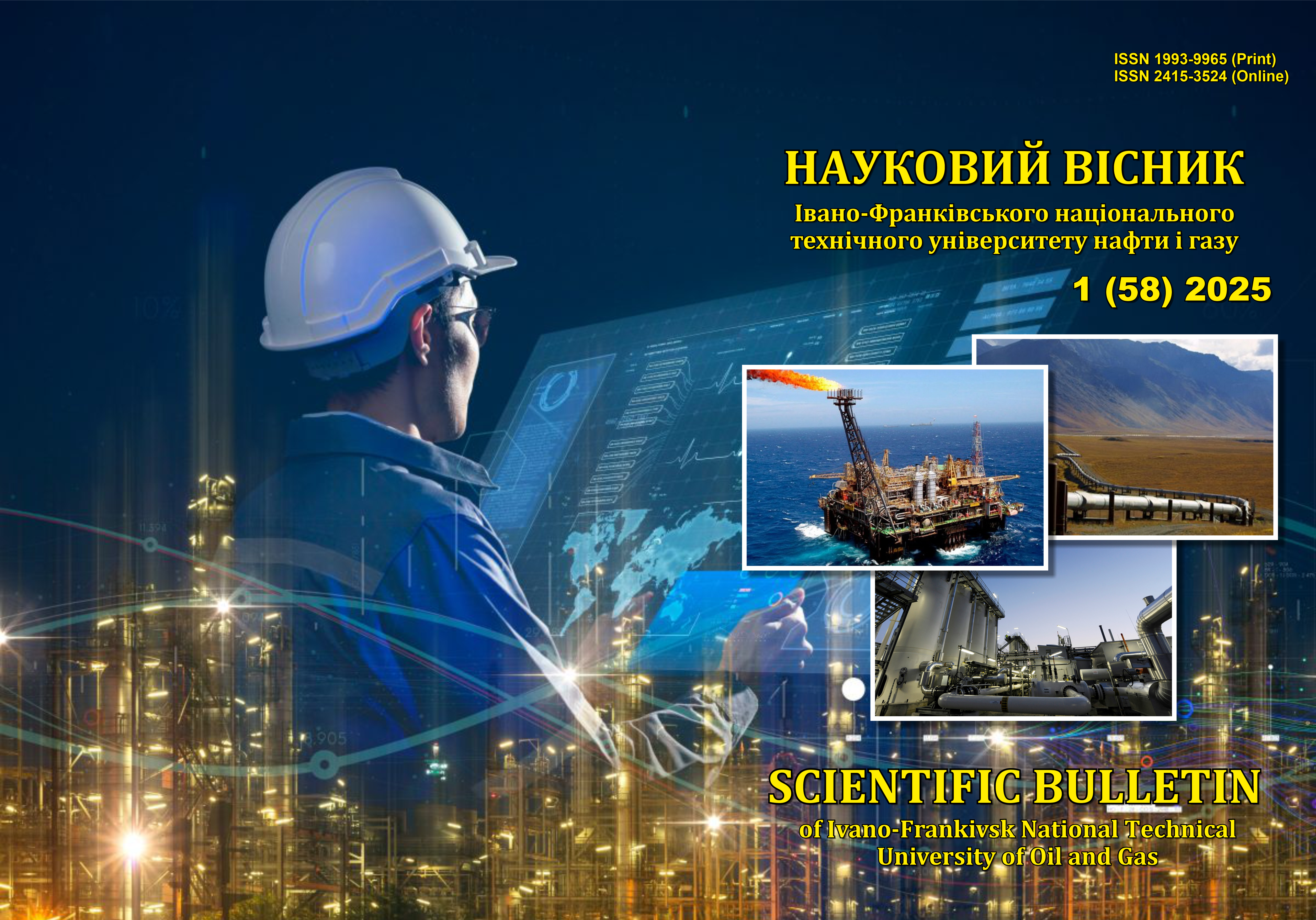GENERATION OF A SYNTHETIC DATASET OF DEFORMED PIPELINES WITH DEFECTS FOR STRESS PREDICTION BASED ON LASER SCANNING DATA
DOI:
https://doi.org/10.31471/1993-9965-2025-1(58)-124-134Keywords:
pipelines, stress-strain state, machine learning, mathematical modeling.Abstract
The article presents a methodology for generating a synthetic dataset for modeling the stress-strain state of pipelines. The main goal is to create labeled data for developing and training machine learning models that will predict internal stresses in the pipeline walls based on measured coordinates of its outer surface. The dataset takes into account a wide range of realistic scenarios. It includes variations in geometric parameters such as the inner radius, the base wall thickness, and the total length of the cylinder. Special attention is paid to the integration of local thickness defects modeled using parameterized Gaussian functions, which allows controlling their characteristics. To increase the reliability and adapt the AI models to real materials, properties such as Young's modulus, Poisson's ratio, and thermal expansion coefficient are stochastically varied for each cylinder. The influence of complex external and internal loads is included: internal and external pressure, axial forces (tensile/compressive), bending moments (simulating non-uniform settlement) and temperature changes that cause thermal stresses. The key feature of the methodology is the simulation of real data collection conditions using laser scanners. Controlled random noise is added to the analytically calculated deformed coordinates of the outer surface of the pipeline. This reflects the typical inaccuracies of optical measurements, ensuring that the input data for the AI model are as close as possible to real field conditions. The proposed methodology allows for the efficient creation of large volumes of labeled data, indispensable for training and validation of deep learning algorithms that solve the inverse problem in materials mechanics. This opens up new opportunities for improving non-destructive testing, structural monitoring and prediction of the remaining resource of pipelines.
Downloads
References
NACE International. SP0102-2010: In-Line Inspection of Pipelines. NACE International, 2018.
American Society for Nondestructive Testing (ASNT). Nondestructive Testing Handbook. Vol. 7: Ultrasonic Testing. 3rd ed. ASNT, 2016.
Yang Z, Yu C.-H. Buehler M. J. Deep learning model to predict complex stress and strain fields in hierarchical composites.. Science Advances. 2021. Vol. 7, No. 15. eabd7416. DOI: http://dx.doi.org/10.1126/sciadv.abd7416
Application of Artificial Intelligence to Support Design and Analysis of Steel Structures /
S. Sarfarazi et al. Metals. 2025, Vol. 15, No. 4. Art. no. 408. DOI: https://doi.org/10.3390/met15040408
AI for Smarter Pipeline Management in Oil and Gas Industry [Electronic resource]. – Numalis. URL: https://numalis.com/ai-pipeline-management-in-oil-and-gas-industry/ (accessed: 02.06.2025).
Martyniuk Kh. V., Oliinyk A. P. Matematychne modeliuvannia napruzheno–deformovanoho stanu dilianok truboprovodu z optymizatsiieiu protsedury zghladzhuvannia pochatkovykh danykh. Metody ta prylady kontroliu yakosti. 2005. No 13. P. 21–25. [in Ukrainian]
Pankiv Kh. V., Pankiv Yu. V. Vykorystannia zghortkovoi hlybokoi neiromerezhi dlia vyznachennia zminy napruzheno-deformovanoho stanu vertykalnykh stalevykh tsylindrychnykh rezervuariv za peremishchenniamy yikh poverkhni. Metody ta prylady kontroliu yakosti. 2020. No 2.
P. 5–12. DOI: https://doi.org/10.31471/1993-9981-2020-2(45)-5-12 [in Ukrainian]
Digital Transformation in the Oil & Gas Sector [Electronic resource]. Rimini Street. URL: https://www.riministreet.com/blog/digital-transformation-in-the-oil-and-gas-sector-navigating-the-future-of-energy/ (дата звернення: 01.06.2025).
Machine learning for structural health monitoring: Challenges and opportunities / F.-G. Yuan et al. Proceedings of SPIE – The International Society for Optical Engineering, Huang H., Sohn H., Zonta D. (Eds.). Sensors and Smart Structures Technologies for Civil, Mechanical, and Aerospace Systems 2020, 27 April – 8 May 2020, None. SPIE. 2020. Vol. 11379. Art. no. 1137903. DOI: https://doi.org/10.1117/12.2561610
Synthetic training data generation for deep learning based quality inspection / P. Gutierrez et al. Proceedings of SPIE – The International Society for Optical Engineering Terada K., Nakamura A., Komuro T., Shimizu T. (Eds.). 15th International Conference on Quality Control by Artificial Vision, 12 May – 14 May 2021, Tokushima. SPIE. 2021. Vol. 11794. Art. no. 1179403. DOI: https://doi.org/10.1117/12.2586824
A High-Quality Sample Generation Method for Improving Steel Surface Defect Inspection / Y. He et al. Sensors. 2024. Vol. 24, No. 8. Art. no. 2642. DOI: https://doi.org/10.3390/s24082642
Logg A., Mardal K.-A., Wells G. N. Automated Solution of Differential Equations by the Finite Element Method: The FEniCS Book. Springer, 201– ISBN: 978-3-642-23099-8. DOI: https://doi.org/10.1007/978-3-642-23099-8
Best Finite Element Analysis (FEA) Software – April 2025 Reviews & Comparison [Electronic resource]. SourceForge. URL: https://sourceforge.net/software/finite-element-analysis-fea/ (дата звернення: 02.06.2025).
Shatskyi I., Struk A., Vaskovskyi M. Static and dynamic stresses in pipeline built on damaged foundation. Trans. VŠB – TU Ostrava, Civ. Eng. Ser. 2017. Vol. 17, No. 2. P. 119–124. DOI: https://doi.org/10.1515/tvsb-2017-0036
Kryzhanivs’kyi, E.I., Rudko, V.P., Shats’kyi, I.P. Estimation of admissible loads upon a pipeline in the zone of sliding ground. Mater. Sci. 2004. Vol. 40, No. 4. P. 547–551. DOI: https://doi.org/10.1007/s11003-005-0076-z
Zhang J., Liang Z., Han C. J. Finite element analysis of wrinkling of buried pressure pipeline under strike-slip fault. 2015. Vol. 21, No. 3. P. 31–36. DOI: https://doi.org/10.5755/j01.mech.21.3.8891
Analytical model of oil pipeline overground transitions, laid in mountain areas / A.S. Velychko-vych et al. Oil & Gas Science and Technology–Revue d’IFP Energies nouvelles. 2019. Vol. 74. Art. no. 65. DOI: https://doi.org/10.2516/ogst/2019039
Shats’kyi, I.P., Makoviichuk, M.V. Analysis of the limiting state of cylindrical shells with cracks with regard for the contact of crack lips. Strength Mater. 2009. Vol. 41. P. 560–564. DOI: https://doi.org/10.1007/s11223-009-9166-8
Shats’kyi, I.P. Closure of a longitudinal crack in a shallow cylindrical shell in bending. Mater. Sci. 2005. Vol. 41, No. 2. P. 186–191. DOI: https://doi.org/10.1007/s11003-005-0149-z
Timoshenko S. P., Goodier J. N. Theory of Elasticity. 3rd ed. London : McGrawHill Book Company, 1970. 608 p.
Beer F. P., Johnston E. R., DeWolf J. T., Mazurek D. F. Mechanics of Materials. 7th ed. – New York : McGraw-Hill Education, 2014. 896 p. ISBN: 978-0-07-339823-5.
Downloads
Published
How to Cite
Issue
Section
License
Авторські права....


1.png)

















